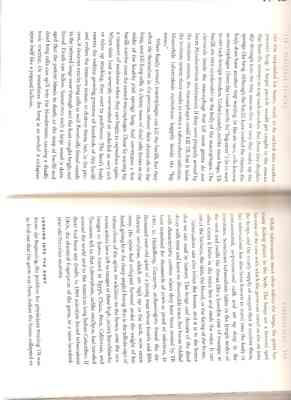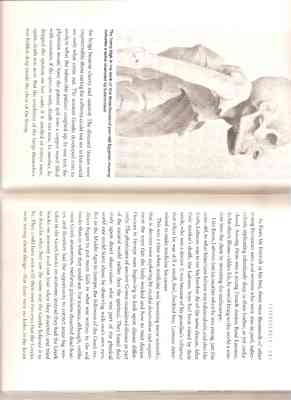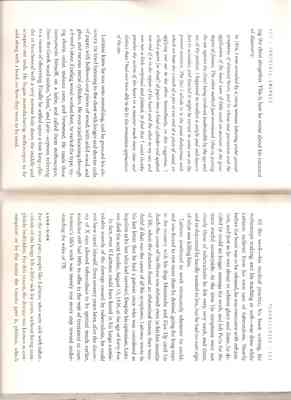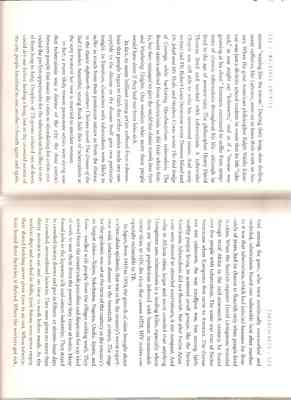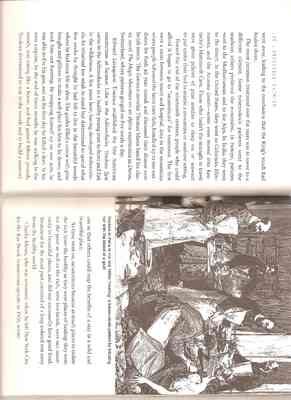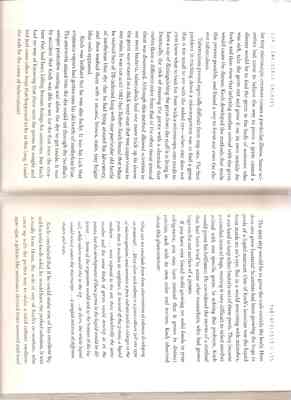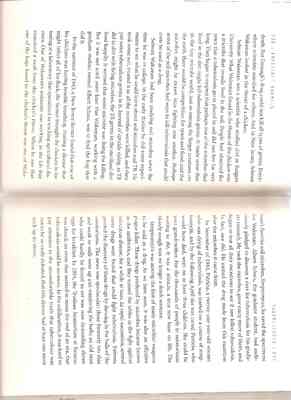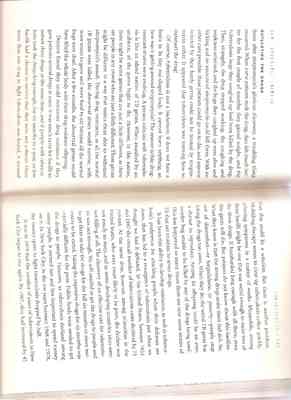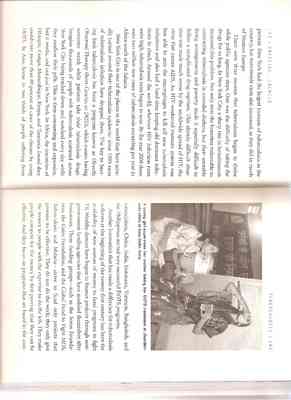Pages needing completion
No pages need transcription from scratch. These pages have been partially transcribed but need to be completed.
Tuberculosis
3
can stay suspended for hours, ready to be sucked into another person's lung. A larger particle would get caught in the mucus that lines the airways to trap such invaders. But these tiny droplets slip through into the tiny mucus-free air sacs that make up the sponge-like lung. Although the bacilli have evaded the mucus, the body does have another trap waiting. In the air sacs, cells known as macrophages (from the Greek words for "big eater") lie in wait to eat such foreign invaders. Unfortunately, unlike most bugs, TB bacilli are very comfortable in the belly of the macrophages. The chemicals inside the macrophage that kill most germs do not harm Mycobacterium tuberculosis. If they were properly armed by the immune system, the macrophages could kill TB, but it takes the immune system, three weeks to notice a tuberculosis infection. Meanwhile tuberculosis reproduces happily inside the "big eaters". When finally armed, macrophages can kill the bacilli, but they often die themselves in the process, release their chemicals in the lung, and kill lung cells. A cheesy mass of dead cells forms in the midst of the healthy pink spongy lung. And sometimes a few bacilli survive even the armed macrophages. These lie waiting for a moment of weakness wehn they can begin to reproduce again. When their host is severely overworked or underfed or very sick or takes up smoking, they start to proliferate. The host's body resents the sudden growing presence of hundreds of tiny bacilli and orders the immune system to destroy them, but, in the process, it destroys nearby lung cells as well. Eventually blood vessels in the tattered lungs wear through and the host coughs bright red blood. Death can follow. Sometimes such a large vessel is damaged that the patient bleeds to death, or the soup of bacilli and dead lung cells can spill into the bloodstream, causing deadly toxic reaction. Or sometimes the lung is so eroded it collapses upon itself like a popped balloon. While tuberculosis most often infects the lungs, the germ has many hiding places in the body. The lungs are a favored spot because of the ease with which the germ can travel on the air into the lungs, and the steady supply of oxygen that it receives there, but tuberculosis has alos been known to travel into the body in contaminated, unpasteurized milk and set up shop in the intestines. Sometimes tuberculosis hides in the lymph nodes of the neck and swells the throat like a horrible case of mumps; at other times it hides in the voice box and steals the voice. It an infect the kidneys, the skin, the blood, or the lining of the brain. Tuberculosis can also infect the bones, and it is in the bones that we can read its history. The lungs and throats of the dead decay with time and leave no discernible trace, but bones riddled with characteristic cavities whre they have been eroded by TB have remained for thousands of years as proof of infection. In 1907, in Heidelberg, Germany, archaeologists found the six-thousand-year old spine of a young man whose fourth and fifth thoracic vertebrae, which are high up in the back, were eaten away. His spine had collapsed forward under the weight of his head, giving him the sharp-angled hump that is the telltale sign of tuberculosis of the spine. In addition to the bones, over the centuries artists have left us images of these high, pointy hunchbacks. Images or bones found in Egypt, China, Peru, California, and Tennessee tell us that tuberculosis, unlike smallpox, had traveled around the world and to the Americas long before Columbus. If there had been any doubt, in 1994 scientists found tuberculosis DNA, the chemical fingerprint of the germ, in a nine-hundred-year-old Peruvian mummy.
4
The hump high in the back of this three-thousand year old Egyptian mummy indicates a spine crumpled by tuberculosis. the lungs became cheesy and tattered. The diseased tissues were impenterable; those caring for sufferers coudl not see in but could see only what came out. The ancient Greeks developed tests to analyze what the tubercular patient coughed up. In one test, the physician would have the patient spit into a copper vessel filled with seawater; if the sputum sank, death was near. In another, he dripped the sputum on hot coals; if it smelle of rotten meat, again, death was near. But the condition of the lungs themselves was hidden deep inside the chest of the living. As Keats lay feverish in his bed, there were thousands of other young European men and women who were also in peril, tuberculosis replicating relentlessly deep in their bodies, and yet undisclosed. Among them was a young French doctor, Rene Laennec. In his short, illness-ridden life, he would bring to the world a window into the chest by inventing the stethocope. Like Keats, Laennec lost his mother when he was young, just five years old, to what historians believe was tuberculosis; and also like Keats, Laennec was to see his brother die of the same disease. After their mother's death, the Laennec boys had been raised by their uncle, who was a doctor. It was because of his guardian's influence that when he was still a small, frail, freckled boy, Laennec determined to make medicine his career. This was a time when medicine was becoming more scientific; that is, doctors were exploring by careful observation and experiment the ways that the body worked and how to treat disease. Doctors in Europe were beginning to look upon disease differently. The physicians of ancient Greece considered disease as part of the natural world rather than the spiritual. They based their study upon direct observation: what was part of the physical world one could learn about by observing with one's own eyes. But in the Middle Ages in Europe, the followers of the Greek tradition began to put more faith in what was written in the old books than in what they could see. For instance, although, unlike most Greek anatomists, medieval physicians dissected dead bodies, and therefore had the opportunity to correct some big mistakes in the Greek books on anatomy, instead they had the Greek books on anatomy read out loud when they dissected, and tried to describe what they saw the same way the Greeks believed it to be. They could have seen with their own two eyes that the Greeks were wrong about things - that there were no holes in the heart
6
ing the chest altogether. This is how he wrote about his moment of discovery. In 1816, I was consulted by a young woman laboring under general symptoms of diseased heart, and in whos case percussion and the application of the hand were of little avail on account of the great degree of fatness. The other method just mentioned [that is, putting the ear against the chest] being rendered inadmissable by the age and sex of the patient, I happened to recollect a simple and well-known fact in acoustics, and fancied it might be turned to some use on the present occasion. The fact I allude to is the great distinctness with which we hear the scratch of a pin at one end of a piece of wood, on applying our ear to the other. Immediately, on this suggestion, I roled a quire [or sheaf] of paper into a kind of cylinder and applied one end of it to the region of the heart and the other to my ear, and was not a little surprised and pleased, to find that I could thereby perceive the action of the heart in a manner much more clear and distinct than I had ever been able to do by the immediate application of the ear. Laennec knew he was onto something, and he pursued his discovery. He tried listening to the chest with longer and shorter coils of paper, with hollowed-out pieces of wood, with solid wood, and glass, and various metal cylinders. He even tried listening through a friend's oboe. Finding wood worked best, he varied the type, trying ebony, cedar, malacca cane, and limewood. He made these instruments himself, on a lathe, and called them stethoscopes, from the Greek word stethos, "chest", and latin -scopium, referring to a means of observing. Finally he settled upon a foot-long cylinder of beechwood with a very narrow hole down the middle and scooped-out ends. He began manufacturing stethoscopes to be sold along with a book on how they were to be used. All this work - his medical practice, his book writing, his stethoscope making, and his teaching as well - was done while Laennec suffered from his own case of tuberculosis. Shortly before the book was to be released, he was overcome with exhaustion, and just as he was about to acheive glory and fame, he decided he could no longer manage his work, and left Paris for the more restful countryside. At the time his symptoms were not clearly those of tuberculosis: he felt very, very weak, and dizzy, and so depressed he hardly wanted to live, but he had no sure sign of what was killing him. Laennec continued to work strenuously whenever he could, and was forced to rest more than he desired, going for long stays in the country with his dogs Moustache and Kiss. Up until his death the cause of his illness was debated: even in his last months of life, when the doctors found an abdominal tumor, they wondered if that was the cause of all his symptoms. Laennec wrote in his last letter that he had a patient once who was considered as hopeless as he but who had survived. Despite his optimism, Laennec died the next Sunday, August 13, 1826, at the age of forty-five. In fact, even if Laennec could have heard in his lungs unmistakable sounds of the damage caused by tuberculosis, he could not have cured himself. Even seventy years later, after the discovery of X rays allowed tuberculosis to be spotted much earlier, medicine still had little to offer in the way of treatment or cure. Laennec's life's work was merely one more step toward understanding the wiles of TB. Luke-Sick For the most part, people like Laennec who were sick with tuberculosis of the lungs felt a little sick for years, without being completely bedridden. For this reason, the disease was known as consumption or by the name the Greeks gave it, phthisis, which
7
means "waning like the moon." During their long, slow decline many sufferers, like Laennec, went on to leave their mark on history. When the great American philosopher Ralph Waldo Emerson was just a divinity school student he wrote that he felt "luke-sick", as one might say "lukewarm", and as if a "mouse was gnawing at his chest." Emerson continued to suffer from symptoms of chronic tuberculosis throughout his life - although he lived to the age of seventy-nine. The philosopher Henry David Thoreau lived and worked with tuberculosis. A tubercular Chopin was still able to write his renowned music. And many writers had TB: Robert Louis Stevenson wrote Treasure Island and Dr. Jekyll and Mr Hyde, and Stephen Crane wrote The Red Badge of Courage, while harboring Mycobacterium Tuberculosis. The Bronte sisters suffered from tuberculosis, as did their whole family, but the managed to give the world the classic novels Jane Eyre and Wuthering Heights. One wonders what more these people would have done if they had not been luke-sick. In fact, so many brilliant young artists suffered from tuberculosis that people began to think that either genius made on susceptible to the disease or the disease itself gave one particular insight. In literature, characters with tuberculosis were likely to suffer as much from their passionate nature as from the disease. In the classic eighteenth-century Chinese novel The Dream of the Red Chamber, beautiful, young Black Jade dies of tuberculosis at the very moment her love is married to another woman. In fact, a more likely reason passionate artists were dying was that tuberculosis was a disease of the city: the close contact between people that made the cities so stimulating for artists provided the perfect opportunity for the tuberculosis bacillus to travel from lung to lung. Droplets of TB germs exhaled out of doors could dry out before finding a lung, but in the crowded rooms of the city, people breathed in one another's breath again and again. And among the poor, who were contnually overworked and underfed, tuberculosis found one vulnerable host after another. So it was that tuberculosis, which had infected humans for thousands of years, had its change to flourish only when people lived in cities. When the Scottish explorer David Livingstone traveled through rural Africa in the mid-nineteenth century, he found very few people with tuberculosis. The same was true of Native Americans when Europeans first came to America. The disease was not unknown, the way smallpox was, but among fairly healthy people living in scattered small groups, like the Native Americans, tuberculosis did not flourish. But after Native Americans were moved to crowded reservations, it ran rampant. And today in African cities, larger and more crowded than anything Livingstone saw, tuberculosis is a leading killer, especially where there are large populations infected with human immunodeficiency virus, or HIV, the virus that causes AIDs. HIV makes one especially vulnerable to TB. In Japan, from 1910 to 1950, the growth of cities brought about a tuberculosis epidemic that was to be the country's worst experience with infectious disease in the twentieth century. The stage of the epidemic was set at the turn of the century as the country's six largest cities - Tokyo, Yokohama, Nagoya, Osaka, Kyoto, and Kobe - swelled with people from the villages seeking work. They arrived from the countryside penniless and desperate for any kind of work to save them from the poverty they knew at home. Mnay found jobs in the Japanese silk and cotton industries. They stayed in crowded factory dorms an put in fifteen- or sixteen-hour days in crowded, unventialted factories. they were given no more than thirty minutes to eat and no time to wash before meals. As the workers slept and worked in shifts, their futons were never empty, their shared bedding never given time to air out. When tuberculosis found these factories, it thrived. When workers got sick,
9
went away, leading to the conclusion that the King's touch had healed them. The most common treatment over the years was to move to a different climate. Some tuberculosis patients went to the seashore; others preferred the mountains. In Europe, patients went to the Mediterranean and to the Alps. In India, they went to the desert. In the United States, they went to Colorado, Minnesota, and the Arizona desert - some even moved into Kentucky's Mammoth Cave. Those who hadn't the strength to travel were given pillows of pine needles to sleep on or seaweed to put under their bed to mimic a mountain or seashore setting. Toward the end of the nineteenth century, people who could afford it began to go to "sanatoriums" for treatment. The first were a cross between resort and hospital, inns in the mountains where people followed the latest cure fads, bundled up to rest outdoors for fresh air year round, and discussed their disease over lavish meals. The German novelist Thomas Mann based his classic novel The Magic Mountain on an alpine sanatorium in Davos, Switzerland, where patients gorged on five meals a day. Edward Livingston Trudeau established the first American sanatorium at Saranac Lake in the Adirondacks. Trudeau first came to the Adirondacks as a healthy young man to hunt and fish in the wilderness. A few years later having developed tuberculosis, he returned too weak to stand but determined to spend what few weeks he thought he had left to live in the beautiful woods where he had once felt so alive. The guides filled a canoe with pine boughs and pillows to make a soft place for him to lie down, and took him out hunting. By propping himself up on one arm, he was able to fire his gun, and on his first day he killed a deer. To his own surprise, by the end of three months he was walking in the woods, was eating like a horse, and had gained fifteen pounds. Trudeau determined to stay in th woods and to build a sanatiorium so that others could reap the benefits of a stay in the wild and beautiful place. As time went on, sanatoriums became as much places to isolate the sick from the healthy as they were places of healing: they were for the poor as well as the rich, were less lavish, were not necessarily in beautiful places, and did not necessarily have good food. Treatment for the most part consisited of a long isolated rest away from the healthy world. Charles Moses, who was seventeen when he left New York City for the Ray Brook Sanatorium upstate in 1920, wrote:
10
I spent probably the happiest eleven months of my life in that sanatorium. It was a place which opened my eyes to the world... My parents didn't come up for eleven months. Nobody, nobody came up because it was supposed to have been a secret. In those days, tuberculosis was a disease which you were supposed to conceal. It was almost like a venereal disease is now. And when my mother used to send me "care" packages of food and gifts and she would meet one of her sisters living in the area and they would see her, they would ask, "Where are you taking this?" "I am taking this to Charlie", she would say. "He is in college." Cast out of the world of the healthy, tuberculosis patients created a world of their own in the sanatoriums. One young American patient, Betty MacDonald, who was a thirty-year-old working single mother of two girls when she found out she tuberculosis, describes entering the sanatorium world: Getting tuberculosis in the middle of your life is like starting down-town to do a lot of urgent errands and being hit by a bus. When you regain consciousness, you remember nothing about the urgent errands. You can't even remember where you were going. The important things now are the pain in your leg; the soreness in your back; what will you have for dinner; who is in the next bed. Patients could spend five, ten, even twenty years in a numbing routine of bed rest and meals. When first admitted to the sanatorium she calls "The Pines" in 1938, MacDonald had to spend every day lying down: that meant no reading, no talking, no laughing, no reaching too far out of bed to get things. Betty was informed sternly that her red hair would be a liability, as a red-head was likely to be viviacious and thus have difficulty lying still and solemn. Not lying still, she was told, would lead to death. Things did get better: after three months at the Pines, if you showed improvement, you could go outside on the sleeping porch and lie still, bundled in blankets against the cold. MacDonald began to think that life in the sanatorium would "make dying seem like a lot of fun." Because patients lived in sanatoriums, sharing their rooms with total strangers, for months and years of their lives, the sanatorium world brought out the prejudice in people, and separate hospitals wre built for blacks and Native Americans to stay. Although it might have been hard for Betty MacDonald to imagine a worse place to spend the first years of her thirties, a young Lakota woman, Madonna Swan, wrote of a sanatorium stay that was even more dreadful and nearly deadly. Madonna Swan was just sixteen when she found she had tuberculosis. She had seen four schoomates suddenly begin to cough blood and rapidly die from the disease. She knew all too well where the chest pains and cough that she shared with them would lead, but Madonna was sent to the doctor before it was too late, and he sent her to the "Sioux San." That was in 1944. During the first two years Madonna Swan spent at the Sioux San, no patient left alive - no one even went out on leave: the only patients to leave were the dead. The patients were all dressed in striped uniforms, like prisoners. Meals were beans and cornmeal spotted with mouse droppings. The healthier patients spent the morning bathing the sicker ones, and they all spent the afternoons from one to five lying on their beds with bean bags on their chests. Madonna's treatment consisted of four pounds of bean bags on the chest and one cup of cod-liver oil to drink daily. The bean bags were supposed to compress the lungs and suffocate the germs. After six years of this treatment, to doctor
13
lar tiny microscopic creature causes a particular illness. Some scientists had come to believe the way to prove a germ caused a disease would be to find the germ in the body of someone who was sick, take the germ out and grow it on its own outside the body, and then show that infecting another animal with the germ would cause the disease. Koch developed the methods that made this process possible, and found a way to ferret out even the elusive tuberculosis. Tuberculosis proved especially difficult from step one. The first problem in tracking down a microorganism was to find a germ that is too small to see with the naked eye - when one does not even know what to look for. Even with a microscope, one needs to have a way of distinguishing the germ from the stuff it is living in. Eventually, the trick of staining the germs with a chemical that makes them a different color from that of the other tissue around them was discovered. Although this method allowed scientists to see most bacteria, tuberculosis had one more trick up its sleeve: the germ was encased in a thick waxy coat that was impervious to any stain. It was not until 1882 that Robert Koch found that when he stained bits of TB-infected lung with one particular old bottle of methylene blue dye that he had lying around his laboratory, and then washed them with a second, brown, stain, tiny bright blue rods appeared. Koch was brilliant but he was also lucky. It was his luck that ammonia vapors had gotten into his old bottle of methylene blue. The ammonia mixed into the dye could eat through the bacillus's unique protective coating and allow the dye to get inside. It was by accident that Koch was able to see for the first time the creature that had been killing human beings for centuries. But Koch had no way of knowing that these were the germs he sought and not just some other bugs that happened to be in this lung. Could the rods be the cause of tuberculosis? The next step would be to grow the rods outside the body. How does one grow bacteria? Scientists had been growing the bugs in pools of a liquid nutrient. One of Koch's favorites was the liquid from inside an ox's eye. But in a world swarming with microbes, it was hard to keep other bacteria out of these pools. They became a crowded mess of bugs, making it very difficult to infect another animal with one specific germ. In solving this problem, Koch would prove his brilliance. He considered the merits of a method that had been tried by some other researchers, who had grown bugs on the cut surface of a potato. If you have ever found mold growing on solid foods in your refrigerator, you may have noticed that it grows in distinct patches, each with its own color and texture. Koch observed about this phenomenon: What can we conclude from these observations of colonies developing on potatoes?...Most often each colony is a pure culture [all one type of microorganism] and remains a pure culture until it enlarges to the point that it touches its neighbors. If instead of the potato, a liquid medium....were exposed to the air, then undoubtedly the same number and the same kinds of germs would develop as on the potato, but the development of these germs in the liquid would be different...Some of the organisms would sink to the bottom of the liquid, while others would rise to the top...In short, the whole liquid would reveal under the microscope...a tangled mixture of different shapes and sizes. Koch concluded that if he could make one of his excellent liquid bacteria foods solid, he would have the perfect solution. It was actually Frau Hesse, the wife of one of Koch's co-workers, who came up with the perfect way to make a solid culture medium: agar-agar, a gelatin-like substance derived from seaweed and used
15
death. But Domagk's drug could not kill all types of germs. Everywhere scientists searched for others. And in New Jersey, Selman Waksman looked in the throat of a chicken. Selman Waksman was a scientist who studied dirt at Rutgers University. What Waksman found in the throat of the chicken was a microbe that usually lived in the soil. People had observed for years that a tuberculosis germ placed in soil did not live for very long. They began to suspect that perhaps one of the microbes that lived in the soil. People had observed for years that a tuberculosis germ placed in soil did not live for very long. They began to suspect that perhaps one of the microbes that lived in the dirt might kill tuberculosis germs. It made sense that in the tiny microbe world, just as among the larger creatures on the earth, there would be competition for space and food, and the microbes might be drawn into fightin one another. Perhaps some of the soil microbes had ways to kill tuberculosis that could even be used as a drug. Selman Waksman had been studying soil microbes since the time he was in college. In the early thirties he did some experiments to see what he could learn about soil microbes and TB. He took some soil, treated it so all the microbes were killed, and then put some tuberculosis germs in it. Instead of quickly dying, as TB did in dirt with living microbes, the TB germs in the sterilized dirt lived happily. It seemed that some microbe was doing the killing. But it was not until years later that Waksman, working with a graduate student named Albert Schatz, was to find the bug that did it. In the summer of 1943, a New Jersey farmer found that one of his chickens was having trouble breathing. Fearing a disease that might infect all his flock, the farmer brough the chicken in for testing at a laboratory that specialized in tracking agricultural diseases. One of Wakman's assistants was working in the lab that examined a swab from this chicken's throat. When he saw that one of the bugs found in the chicken's throat was on of Waksman's favorite soil microbes, Streptomyces, he saved the specimens for Waksman. Albert Schatz, the graduate student, had audaciously pledged to discover a cure for tuberculosis for his graduate research. He took the microbes, grew many more of them, and began to test all their excretions to see if one killed tuberculosis. In fact, one did. He name the drug made from this excretion after the microbes it came from. In November of 1944, Patricia, a twenty-one year old woman who was dying of tuberculosis, was started on a course of stretomycin, and by the following April she was cured. Patricia, who would have died, went on to have three children. She could be your grandmother. For the thousands of people in sanatoriums waiting to die, it was a miracle, a true new lease on life. The bloody cough was no longer a death sentence. Streptomycin was among the first of many microbial weapons to be sold as a drug. As we have seen, it was also an effective plague killer. These drugs produced by microbes became known as the antibiotics, and they turned the tables in the fight against infectious disease, for a while at least. In rapid succession, several more drugs were found that could fight tuberculosis. Patients greeted the discovery of these drugs by dancing in teh halls of the sanatoriums. The news was spectacular: those formerly too thin and weak to walk were up and wandering the halls; an old man who could hardly be forced to eat was now demanding eleven eggs for breakfast. In 1954, the Trudeau Sanatorium at Saranac was closed, an event that seemed to mean the end of an era, that tuberculosis would be no more. In the exhiliration, it was hard to pay attention to the uncomfortable truth that tuberculosis was not to be so easily defeated, that this disease had at least one more trick up its sleeve.
16
OUTLASTING THE DRUGS Soon after streptomycin's glorious discovery, a troubling thing occurred. When some patients took the druge, they felt much better for the first couple of months: they gained weight, and the tuberculosis bugs they coughed up had been killed by the drug. Then, strangely, the drug stopped working, the coughing and weakness returned, and the bugs they coughed up were alive and kicking and no amount of streptomycin could kill them. With no other cure possible, these patients could go on to die, and anyone infected by their hardy germs could not be treated by streptomycin either. It appeared that tuberculosis was learning how to outsmart the drug! Of course, tuberculosis is just a bacterium; it does not have a brain in its tiny rod-shaped body. It cannot learn anything, so how was it getting around streptomycin? The answer is this drug: drug-resistant strains were evolving. A person infected with tuberculosis is like an island nation of TB germs. When assaulted by an antibiotic, all the germs begin to die. However, in this nation, there might be some germs that are just a little different, as there are people in any crowd who are just a little different. These germs might be different in a way that makes them able to withstand streptomycin's assault. During drug treatment, as all the normal TB germs were killed, the abnormal strain would survive, with more room to grow and more food to eat because all the normal bugs were dead. After a few months, the abnormal germs would have filled the whole body with their drug-resistant offspring. Doctors found they could overcome drug resistance if they gave patients several drugs at once: it was much rarer for bacilli to outwit three drugs at the same time, and if people with tuberculosis took the drugs long enough, for six months to a year, so few bacilli had a chance to survive that they were not a threat. Once more than one drug to fight tuberculosis was found, it seemed that this could be a solution. But there is another problem. Multidrug therapy seems to clear up tuberculosis rather quickly, relieving symptoms in a matter of weeks. Meanwhile, among these bacilli might be one that was weird enough to resist two of the three drugs. If bombarded long enough with all three, even this germ will die. But patients do not konw about this bacillus. What they know is that the strong drugs make them feel sick. So, out of discomfort - or forgetfulness, or poverty - people stop taking the drugs too soon. When they do, the weird TB germ has a chance to reproduce. Among its offspring could be an even weirder bug unable to be killed by any of the drugs being used. This has happened so many times there are now some strains of TB that are resistant to seven drugs. It has been this ability to develop resistance, as well as tuberculosis's preference for attacking poeple when their defenses are down, that has led to a resurgence of tuberculosis just when we thought we had it defeated. In the United States, between 1953 and 1987 the overall number of tuberculosis cases declined by 73 percent. At the same time, however, among minorities in the United States, who were more likely to be poor, the decline was not nearly so steep, and in some developing countries rates were not falling at all. The discovery of an effective cure for tuberculosis was not enough. We still needed to get the drugs to people and to get them to take the drugs for the full six months or more necessary to be cured. Taking the expensive drugs for six months was especially difficult for the poor. Public funds were needed to get the drugs to people. However, as tuberculosis declined among many people, it seemed less and less important to spend money on it. In New York City, in the ten years between 1968 and 1978, the money spent to fight tuberculosis dropped by half. It was in 1979 that the number of cases of tuberculosis in New York City began to rise again. By 1987, they had increased by 45
17
percent. New York had the largest increase of tuberculosis in the country, but nationwide rates also increased, as they did in much of Western Europe. There were three reasons that tuberculosis began to thrive while public agencies slept. One was the difficulty of taking the drugs for so long. In New York City, a sharp rise in homelessness increased this problem. Not only were the homeless vulnerable to contracting tuberculosis in crowded shelters, but their unstable living arrangements and poverty made it especially difficult to follow a complicated drug regimen. This already difficult situation was made much worse by the worldwide spread of HIV, the virus that causes AIDS. An HIV-weakened immune system was less able to arm the macrophages to kill off new tuberculosis infections and also had a hard time keeping old dormant infections in check. Around the world, wherever HIV infection rates were high, tuberculosis rates began to soar. By the year 2000 there were two million new cases of tuberculosis occurring per year in Africa south of the Sahara. New York City is one of the places in the world that have actually turned around their tuberculosis epidemic: since 1993 rates of tuberculosis infection have dropped there. The key to beating back tuberculosis has been a program known as Directly Observed Therapy Short-Course or DOTS, which means having someone watch while patients take their tuberculosis drugs. Imagine thousands of people with tuberculosis scattered across New York City being tracked down and watched every day while they swallow their pills. This is time-consuming and expensive, but it works, and not just in New York. In Africa, the countries of Ethiopia, Congo, Mozambique, Kenya and Tanzania found they could ure more than 80 percent of cases of the disease by using DOT. In Asia, home to two thirds of people suffering from tuberculosis, China, India, Indonesia, Vietnam, Bangladesh, and the Phillipines started very successful DOTS programs. Another innovation that has made a difference for tuberculosis sufferers at the beginning of the twenty-first century has been the availability of new sources of money to fund programs to fight TB. Wealthy donors have begun to finance projects through non-government funding agencies that have modeled themselves after businesses. These funding groups - such as the Soros Foundation, the Gates Foundation, and the Global Fund to Fight AIDS, Tuberculosis and Malaria - strive to fund only projects that promise to be effective. They do not do the work; they only give the money to people with the expertise to do the job. They make people compete for the money by first proving that they can be effective. And they focus on programs that are based in the com-
